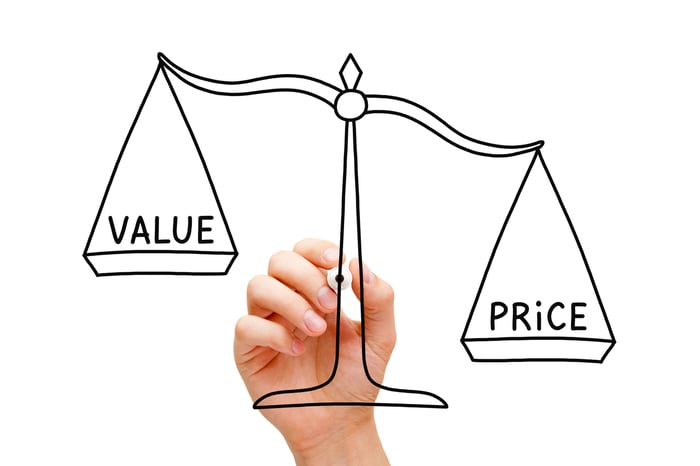Everyone loves a bargain, especially stock investors. However, with the market near all-time highs again, it's hard to find great deals today. But if you look hard enough, you can find some interesting value stories. Right now, you should be looking at niche cancer-drug maker Exelixis (EXEL 0.85%); high-profile social media platform Twitter (TWTR), which is materially growing cash flow; and energy giant ExxonMobil (XOM -1.67%), which looks like it's turned an important corner. Here's a quick rundown on each of these undervalued stocks.
A top cancer stock
George Budwell (Exelixis): Given that oncology is the fastest-growing space within the pharmaceutical industry and the vast majority of experimental drugs fail to reach the market, cancer companies with Food and Drug Administration-approved products tend to garner sizable premiums. However, the mid-cap cancer company Exelixis is currently bucking this prevailing trend in a big way. The biotech's PEG ratio of 0.47 is among the absolute lowest within its particular peer group.

Image source: Getty Images.
Why isn't Exelixis attracting more attention from investors? The touchstone issue is that cabozantinib is set to compete against top-flight drug combinations from both Bristol-Myers Squibb and Merck & Co. in kidney cancer. The market, though, is arguably missing the bigger picture. Cabozantinib should be able to carve out a well-defined and highly profitable niche as a later-line treatment in kidney cancer. In other words, these big-name competitors aren't expected to displace cabozantinib in advanced kidney cancer, or even really change its commercial opportunity for this indication.
Moreover, the market also hasn't caught on to cabozantinib's stellar commercial potential in advanced liver cancer. The drug snagged this high-value indication earlier this year and it's already making headway as an important addition to the therapeutic landscape only a few short months into its launch, according to the company's first-quarter commentary.
The bottom line is that Exelixis is trading at an absurd valuation right now. The company's top line is expected to more than double from here within the next five years -- even with these potent competitors in the picture. This top cancer stock, therefore, should definitely be on your radar if you're on the hunt for an outstanding bargain.
Social media on sale
Brian Stoffel (Twitter): It's harder and harder to find "value" stocks these days. The long-term average P/E ratio for the S&P 500 is about 15. Today, that figure stands at 22. Broadly speaking, this means that stocks are priced about 45% above their long-term average.
The stock I'm recommending as a value has an even higher P/E. After backing out stock-based compensation, Twitter's P/E stands at 37. If we consider the free cash flow ratio, it's not that much better -- at 31. However, I think there's undeniable value in shares that are underappreciated.
The service is working very hard to clean itself up -- and that both costs money and reduces the number of active users that appear in quarterly releases. And yet, by focusing on what it does best -- connecting people in real time -- and cutting out excess spending, it has been a cash flow machine over the past four years.
| Metric | 2015 | 2016 | 2017 | 2018 | TTM | CAGR |
|---|---|---|---|---|---|---|
| Free Cash Flow | $36 million | $544 million | $670 million | $855 million | $975 million | 176% |
TTM = Trailing 12 months. CAGR= Compound annual growth rate. Data source: Yahoo! Finance.
Even if we use 2016 as our starting point, free cash flow has grown at a CAGR of 30% per year. Remember, the business is protected by the network effect: Each additional member makes the overall platform more valuable.
While Twitter may not cater to nearly as wide an audience as Facebook, it has many big-name influencers on its roster. Increasingly, those influencers are drawing more people to the site on a daily basis: Growth in monetizable daily active users actually accelerated to 11% last quarter.
No, it may not be your traditional value stock. But with an improving platform and lots of room to grow its ad load, I still think Twitter is undervalued.
Like buying in the 1990s
Reuben Gregg Brewer (ExxonMobil): Exxon's 4.3% dividend yield is at levels last seen when Bill Clinton was president in the mid-1990s. Its 1.7 price-to-tangible book value ratio hasn't been this low since Reagan and George H. W. Bush were in office in the 1980s. Simply put, based on history, Exxon looks mighty cheap right now.
XOM dividend yield (TTM) data by YCharts.
To be fair, there's a reason for the low price. Exxon's production has been falling for years, while peers have been growing their output. That's not a good trend, but Exxon isn't oblivious to this. In fact, it's been executing well on a plan to get production heading in the right direction again. The problem is that turning an over-$320 billion market cap ship takes time and Wall Street hates to wait.
But that's an opportunity for dividend investors willing to think long term. Meanwhile, Exxon's broad diversification across the upstream (drilling) and downstream (chemicals and refining) sectors gives its portfolio important balance in an often-volatile industry. Add in a conservative balance sheet with long-term debt at less than 10% of the capital structure, and even low oil prices are unlikely to derail its long-term capital investment plans.
The best news in all of this, however, is probably the fact that the energy giant's oil production looks to have hit an important inflection point in the second half of 2018 -- and that's on the strength of just one of its key growth initiatives. If you act now, though, you can still grab this fat yield before Wall Street catches on to Exxon's improving state of affairs.





